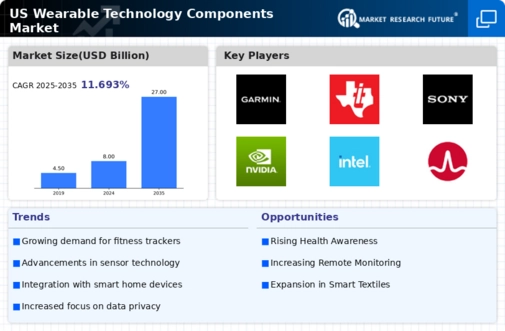Rising Health Consciousness
The increasing awareness of health and fitness among consumers is driving the wearable technology-components market. As individuals seek to monitor their health metrics, such as heart rate, sleep patterns, and physical activity, the demand for advanced wearable devices is surging. In 2025, the market for health-focused wearables is projected to reach approximately $30 billion in the US alone. This trend is further fueled by the integration of sophisticated sensors and analytics, enabling users to gain insights into their well-being. Consequently, manufacturers are investing in innovative components that enhance the functionality of these devices, thereby propelling the growth of the wearable technology-components market.
Growing Demand for Smart Wearables
The escalating demand for smart wearables is a key driver of the wearable technology-components market. Consumers are increasingly seeking devices that offer connectivity and smart features, such as notifications, GPS tracking, and health monitoring. In 2025, the smart wearable segment is expected to account for over 60% of the total market share in the US. This shift towards multifunctional devices is prompting manufacturers to enhance their component offerings, focusing on connectivity solutions and user-friendly interfaces. As a result, the wearable technology-components market is likely to experience robust growth, driven by the integration of smart technologies.
Expansion of E-commerce and Retail Channels
The expansion of e-commerce and retail channels is significantly influencing the wearable technology-components market. As online shopping becomes increasingly popular, consumers have greater access to a variety of wearable devices. In 2025, it is anticipated that online sales will account for over 40% of total sales in the market. This shift is prompting manufacturers to optimize their distribution strategies and enhance customer engagement through digital platforms. The convenience of purchasing wearables online, coupled with targeted marketing efforts, is likely to drive sales and contribute to the overall growth of the wearable technology-components market.
Technological Advancements in Miniaturization
The continuous advancements in miniaturization technology are significantly impacting the wearable technology-components market. As components become smaller and more efficient, manufacturers can create sleeker and more comfortable devices. This trend is evident in the development of compact sensors and batteries that maintain high performance while reducing size. In 2025, it is estimated that the miniaturization of components will contribute to a 15% increase in the market's overall value. The ability to integrate advanced functionalities into smaller devices appeals to consumers, driving demand and fostering innovation within the wearable technology-components market.
Increased Investment in Research and Development
the wearable technology-components market is witnessing a surge in investment for research and development. Companies are allocating substantial resources to innovate and improve the performance of wearable devices. In 2025, R&D spending in this sector is projected to exceed $5 billion in the US, reflecting a commitment to advancing technology and meeting consumer demands. This investment is likely to lead to the development of new materials, enhanced battery life, and improved sensor accuracy. Consequently, the focus on R&D is expected to drive the growth of the wearable technology-components market, fostering a competitive landscape.























Leave a Comment